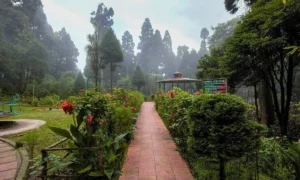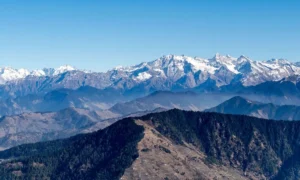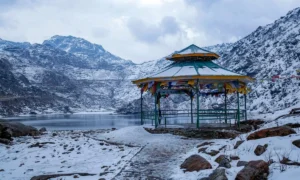In this article, you will learn about the Netaji Subhash Chandra Bose Museum Kurseong, what makes it a must-visit destination, and how you can experience its rich history for yourself. So, let us get ready to explore the legacy of a legend.
Are you looking for a place that combines beautiful scenery with a deep dive into Indian history? Have you ever wondered about the secret places where great historical figures found solace or planned their next moves? Perhaps you have heard whispers of a serene hill station in the Darjeeling district, a place where a famous freedom fighter once stayed. If these questions pique your curiosity, then you are about to embark on a fascinating journey. It is a journey to a little-known gem that holds a significant part of India’s past: the Netaji Subhash Chandra Bose Museum (Giddapahar) Kurseong.
Many people know Kurseong for its stunning tea gardens and panoramic views of the Himalayas, but few are aware of its hidden historical treasures. This peaceful town was once a crucial hideaway for Netaji Subhash Chandra Bose, one of India’s most revered national heroes. The museum, located at Giddapahar, Kurseong, is not just a building; it is a time capsule filled with his personal belongings, historical documents, and the stories of his time there. We are here to uncover the stories behind this historical site.
Exploring the Historical Significance of Netaji’s Kurseong Retreat
The house at Giddapahar, which now serves as the Netaji Subhash Chandra Bose Museum, is more than just a historical building. It is a monument to a pivotal period in the life of a revolutionary leader. Netaji Subhash Chandra Bose stayed at this very house in 1939. This was a crucial time, just before World War II and the subsequent escalation of the freedom movement. His stay here was not a mere vacation; it was a time of serious planning and reflection. For many, the Kurseong museum offers a rare glimpse into the personal life of Netaji, far from the public stage. It provides insight into his thoughts, his strategies, and his personal struggles during that period.
The Subhash Chandra Bose Kurseong retreat was a strategic choice. The quiet, secluded environment of Giddapahar provided the perfect cover for him to plan his future actions without attracting unwanted attention. The cool climate and serene surroundings also offered a much-needed respite from the political turmoil of the time. The house itself, a simple bungalow, has been preserved with great care. It feels as though time has stood still, allowing visitors to walk in the footsteps of the great leader. The museum showcases artifacts from his time there, including photographs, furniture, and personal items. These items tell a powerful story of his commitment to India’s independence.
The Artifacts and Exhibits at the Museum
When you visit the Netaji museum in Kurseong, you will find a collection of artifacts that are both personal and historically significant. The exhibits are arranged to guide you through Netaji’s life and his connection to this particular place.
- Personal Belongings: You will see items that belonged to Netaji himself, such as his clothing and his writing desk. These objects provide a very human connection to the legend, reminding us that he was a person with everyday habits and routines.
- Photographs and Documents: The museum houses a collection of old photographs, including those of Netaji with his family and fellow freedom fighters. There are also copies of letters and documents that shed light on his political ideologies and his plans for the Indian National Army (INA).
- Archival Footage: In some sections, you may find small video presentations showing archival footage related to Netaji’s life and the independence movement. These visuals bring the history to life, making the experience more engaging.
According to a historical curator from the museum, the collection is meticulously maintained to ensure its authenticity. The goal is to preserve the legacy of Netaji for future generations. It is a space for education and inspiration.
Getting There: Your Guide to a Historical Trip Netaji Subhash Chandra Bose Museum Kurseong
Planning a visit to the Netaji Subhash Chandra Bose Museum is an adventure in itself. Kurseong is well-connected to nearby cities like Siliguri and Darjeeling.
- By Air: The nearest airport is Bagdogra (IXB). From there, you can hire a taxi or take a shared vehicle to Kurseong. The drive is scenic, taking you through lush tea estates and winding hill roads.
- By Rail: The New Jalpaiguri (NJP) railway station is the closest major rail hub. Like with the airport, you can easily find transportation from NJP to Kurseong.
- By Road: Kurseong is a well-known hill station, and many private and shared taxis operate from Siliguri and Darjeeling. The road trip is beautiful, offering magnificent views of the surrounding mountains and valleys.
Once you are in Kurseong, the museum is a short distance from the main town center. It is advisable to hire a local taxi or a guide who knows the area well. The Giddapahar Kurseong museum is situated in a quiet residential area, which adds to its peaceful charm.
Why the Museum is a Must-Visit for History Buffs and Students
Visiting the Netaji Subhash Chandra Bose Museum in Kurseong offers a unique educational experience that textbooks cannot replicate. It provides a tangible connection to history, allowing visitors to feel the atmosphere and imagine the life of one of India’s greatest heroes. This is especially beneficial for students of history, as it helps to cement their understanding of the independence movement. The museum is a valuable resource for research and academic study. It is also an important place for anyone interested in Kurseong tourism and its historical landmarks.
The museum’s location itself, nestled in the serene hills, adds to its appeal. The quiet setting allows for peaceful contemplation. It gives you a chance to reflect on Netaji’s vision and his immense sacrifices for the nation. This is a powerful experience, far removed from the hustle and bustle of city life. The Netaji house Kurseong stands as a silent witness to a crucial chapter in Indian history.
Kurseong Attractions: Distances from the Netaji Subhash Chandra Bose Museum, Kurseong
| Destination | Approximate Distance from Museum | Approximate Travel Time |
| Eagle’s Crag (E.C) | 4.4 km | 15 minutes (by car), 1h (on foot) |
| Giddapahar View Point | Less than 200 m | 3 minutes (on foot) |
| Dow Hill Eco Park (Deer Park) | 9.3 km | 32 minutes (by car) |
| Forest Museum, Dowhill | 9.3 km | 32 minutes (by car) |
| Giddapahar Seti Mata Mandir | Less than 1 km | 10 minutes (on foot) |
| Ambotia Shiva Mandir | 11.5 km | 38 minutes (by car) |
| British-era Churches and Schools | 7.3 km | 27 minutes (by car) |
| Bhangzang Salamander Lake | 18.8 km | 54 minutes (by car) |
| Ambootia (Ambotia) Tea Estate | 10.4 km | 34 minutes (by car) |
| Makaibari Tea Estate | 6.6 km | 21 minutes (by car) |
| Castleton and other gardens | 3.9 km | 11 minutes (by car) |
Frequently Asked Questions (FAQs) Netaji Subhash Chandra Bose Museum Kurseong
1. What are the opening hours of the Netaji Subhash Chandra Bose Museum in Kurseong?
The museum is typically open from 10:00 AM to 4:00 PM on most days. It is advisable to check for specific timings and any holiday closures before you visit.
2. Is there an entry fee to visit the museum?
Yes, there is a nominal entry fee. The fees are used for the maintenance and preservation of the historical site and its artifacts.
3. How much time does it take to explore the museum?
You can typically explore the museum in about one to two hours. This time allows for a detailed viewing of all the exhibits and reading the information panels.
4. Is photography allowed inside the museum?
Photography is generally not permitted inside the museum to protect the delicate artifacts and documents. You can, however, take photographs of the exterior and the surrounding grounds.
A Journey of Legacy and Inspiration Netaji Subhash Chandra Bose Museum Kurseong
In conclusion, the Netaji Subhash Chandra Bose Museum (Giddapahar) Kurseong is a historical treasure that offers much more than a simple tour. It is a journey into the life of a great leader, a chance to connect with a crucial period in India’s fight for freedom, and a peaceful retreat in the beautiful hills of Kurseong. The museum and the Netaji Subhash Chandra Bose Kurseong house stand as powerful reminders of the sacrifices made for our nation’s independence.
We encourage you to add this unique destination to your travel itinerary. Take the time to explore the exhibits, reflect on the history, and share your experiences with others. If you have visited this historical site or have more questions, we would love to hear from you.
Please leave a comment below and share your thoughts.



